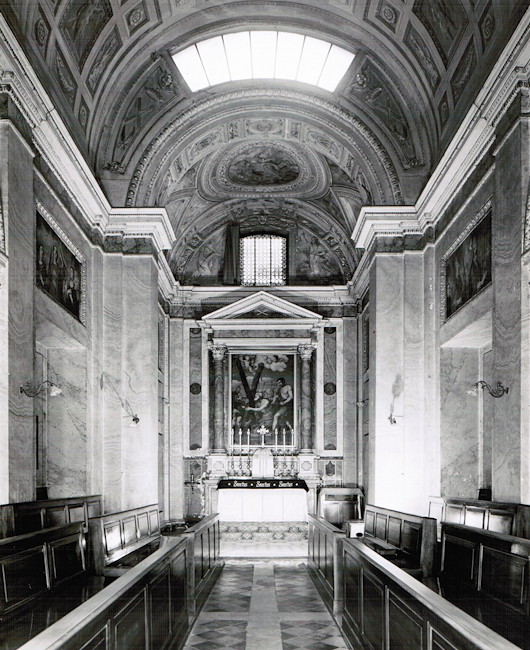Church
About Andrew Cusack
 Writer, web designer, etc.; born in New York; educated in Argentina, Scotland, and South Africa; now based in London.
Writer, web designer, etc.; born in New York; educated in Argentina, Scotland, and South Africa; now based in London. read more
News
Blogs
Reviews & Periodicals
Arts & Design
World
France
Mitteleuropa
Knickerbockers
Argentina
The Levant
Africa
Cape of Good Hope
Netherlands
Scandinavia
Québec
India
Muscovy
Germany
Academica
Warwick Street Church
Over in Soho there is a curious little church with a fascinating history. The parish of Our Lady of the Assumption & St Gregory in Warwick Street started out as the house chapel for the Portuguese embassy in Golden Square, later occupied by the Bavarian embassy.
In recent years the Archdiocese of Westminster has placed the church in the care of the Ordinariate of Our Lady of Walsingham, and they have put new life into the strong musical tradition of the parish.
As chance would have, in my capacity as a professional web designer I was commissioned to design a new website for the parish.
You can view the new Warwick Street website here, and read a little more about its interesting history and architecture.
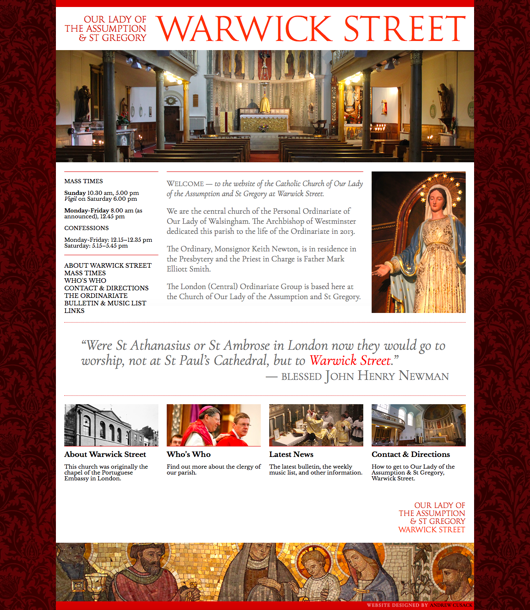
‘The right thing to do is to act virtuously, rather than just talk about doing so’
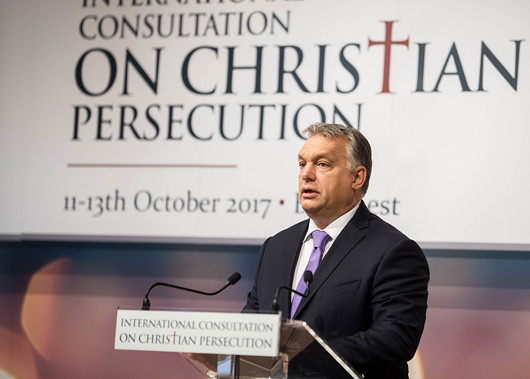
Welcome to Budapest. Today I do not wish to talk about the persecution of Christians in Europe. The persecution of Christians in Europe operates with sophisticated and refined methods of an intellectual nature. It is undoubtedly unfair, it is discriminatory, sometimes it is even painful; but although it has negative impacts, it is tolerable. It cannot be compared to the brutal physical persecution which our Christian brothers and sisters have to endure in Africa and the Middle East. Today I’d like to say a few words about this form of persecution of Christians. We have gathered here from all over the world in order to find responses to a crisis that for too long has been concealed. We have come from different countries, yet there’s something that links us – the leaders of Christian communities and Christian politicians. We call this the responsibility of the watchman. In the Book of Ezekiel we read that if a watchman sees the enemy approaching and does not sound the alarm, the Lord will hold that watchman accountable for the deaths of those killed as a result of his inaction.
Dear Guests,
A great many times over the course of our history we Hungarians have had to fight to remain Christian and Hungarian. For centuries we fought on our homeland’s southern borders, defending the whole of Christian Europe, while in the twentieth century we were the victims of the communist dictatorship’s persecution of Christians. Here, in this room, there are some people older than me who have experienced first-hand what it means to live as a devout Christian under a despotic regime. For us, therefore, it is today a cruel, absurd joke of fate for us to be once again living our lives as members of a community under siege. For wherever we may live around the world – whether we’re Roman Catholics, Protestants, Orthodox Christians or Copts – we are members of a common body, and of a single, diverse and large community. Our mission is to preserve and protect this community. This responsibility requires us, first of all, to liberate public discourse about the current state of affairs from the shackles of political correctness and human rights incantations which conflate everything with everything else. We are duty-bound to use straightforward language in describing the events that are taking place around us, and to identify the dangers that threaten us. The truth always begins with the statement of facts. Today it is a fact that Christianity is the world’s most persecuted religion. It is a fact that 215 million Christians in 108 countries around the world are suffering some form of persecution. It is a fact that four out of every five people oppressed due to their religion are Christians. It is a fact that in Iraq in 2015 a Christian was killed every five minutes because of their religious belief. It is a fact that we see little coverage of these events in the international press, and it is also a fact that one needs a magnifying glass to find political statements condemning the persecution of Christians. But the world’s attention needs to be drawn to the crimes that have been committed against Christians in recent years. The world should understand that in fact today’s persecutions of Christians foreshadow global processes. The world should understand that the forced expulsion of Christian communities and the tragedies of families and children living in some parts of the Middle East and Africa have a wider significance: in fact they threaten our European values. The world should understand that what is at stake today is nothing less than the future of the European way of life, and of our identity.
Ladies and Gentlemen,
We must call the threats we’re facing by their proper names. The greatest danger we face today is the indifferent, apathetic silence of a Europe which denies its Christian roots. However unbelievable it may seem today, the fate of Christians in the Middle East should bring home to Europe that what is happening over there may also happen to us. Europe, however, is forcefully pursuing an immigration policy which results in letting extremists, dangerous extremists, into the territory of the European Union. A group of Europe’s intellectual and political leaders wishes to create a mixed society in Europe which, within just a few generations, will utterly transform the cultural and ethnic composition of our continent – and consequently its Christian identity.
Ladies and Gentlemen,
We Hungarians are a Central European people; there aren’t many of us, and we do not have a great many relatives. Our influence, territory, population and army are similarly not significant. We know our place in the ranking of the world’s nations. We are a medium-sized European state, and there are countries much bigger than us which should, as a matter of course, bear a great deal more responsibility than we do. Now, however, we Hungarians are taking a proactive role. There are good reasons for this. I can see – and I know through having met them personally – how many well-intentioned truly Christian politicians there are in Europe. They are not strong enough, however: they work in coalition governments; they are at the mercy of media industries with attitudes very different from theirs; and they have insufficient political strength to act according to their convictions. While Hungary is only a medium-sized European state, it is in a different situation. This is a stable country: the political formation now in office won two-thirds majorities in two consecutive elections; the country has an economic support base which is not enormous, but is stable; and the public’s general attitude is robust. This means that we are in a position to speak up for persecuted Christians. In other words, in such a stable situation, there could be no excuse for Hungarians not taking action and not honouring the obligation rooted in their Christian faith. This is how fate and God have compelled Hungary to take the initiative, regardless of its size. We are proud that for more than a thousand years we have belonged to the great family of Christian peoples. This, too, imposes an obligation on us.
Dear Guests,
For us, Europe is a Christian continent, and this is how we want to keep it. Even though we may not be able to keep all of it Christian, at least we can do so for the segment that God has entrusted to the Hungarian people. Taking this as our starting-point, we have decided to do all we can to help our Christian brothers and sisters outside Europe who are forced to live under persecution. What is interesting about this decision is not the fact that we are seeking to help, but the way we are seeking to help. The solution we settled on has been to take the help we are providing directly to the churches of persecuted Christians. We are not using the channels established earlier, which seek to assist the persecuted as best they can within the framework of international aid. Our view is that the best way to help is to channel resources directly to the churches of persecuted communities. In our view this is how to produce the best results, this is how resources can be used to the full, and this is how there can be a guarantee that such resources are indeed channelled to those who need them. And as we are Christians, we help Christian churches and channel these resources to them. I could also say that we are doing the very opposite of what is customary in Europe today: we declare that trouble should not be brought here, but assistance must be taken to where it is needed.
Dear Friends,
Our approach is that the right thing to do is to act virtuously, rather than just talk about doing so. In this way we avoid doing good things simply in order to burnish our reputation: we avoid doing good things out of calculation, as good deeds must come from the heart, and for the glory of God. Yet now it is my duty to talk about the facts of good deeds. My justification, the reason I am telling you all this, is to prove to us all that politics in Europe is not necessarily helpless in the face of the persecution of Christians. The reason I am talking about some good deeds is that they may serve as an example for others, and may induce others to also perform good deeds. So please consider everything that I say now in this light. In 2016 we set up the Deputy State Secretariat for the Aid of Persecuted Christians, which – in cooperation with churches, non-governmental organisations, the UN, The Hague and the European Parliament – liaises with and provides help for persecuted Christian communities. We listen to local Christian leaders and to what they believe is most important, and then do what we have to. From them I have learnt that the most important thing we can do is provide assistance for them to return home to resettle in their native lands. We Hungarians want Syrian, Iraqi and Nigerian Christians to be able to return as soon as possible to the lands where their ancestors lived for hundreds of years. This is what we call Hungarian solidarity – or, using the words you see behind me: “Hungary helps”. This is why we decided to help rebuild their homes and churches; and thanks to Hungarian Interchurch Aid, in Iraq, Syria and Lebanon we also build community centres. We have launched a special scholarship programme for young people raised in Christian families suffering persecution, and I am pleased to welcome some of those young people here today. I am sure that after their studies in Hungary, when they return to their communities, they will be active, core members of those communities. And we are also working in cooperation with the Pázmány Péter Catholic University on the establishment of a Hungarian-founded university. The Hungarian government has provided aid of 580 million forints for the rebuilding of damaged homes in the Iraqi town of Tesqopa, as a result to which we hope that hundreds of Iraqi Christian families who now live as internal refugees may be able to return to their homes. We likewise support the activities of the Syriac Catholic Church and the Syriac Orthodox Church. I should also mention something which perhaps does not sound particularly special to a foreigner, but, believe me, here in Hungary is unprecedented, and I can’t even remember the last time something like it happened: all parties in the Hungarian National Assembly united to support adoption of a resolution which condemns the persecution of Christians, supports the Government in providing help, condemns the activities of the organisation called Islamic State, and calls upon the International Criminal Court to launch proceedings in response to the persecution, oppression and murder of Christians.
Ladies and Gentlemen,
When we support the return of persecuted Christians to their homelands, the Hungarian people is fulfilling a mission. In addition to what the Esteemed Bishop has outlined, our Fundamental Law constitutionally declares that we Hungarians recognise the role of Christianity in preserving nationhood. And if we recognise this for ourselves, then we also recognise it for other nations; in other words, we want Christian communities returning to Syria, Iraq and Nigeria to become forces for the preservation of their own countries, just as for us Hungarians Christianity is a force for preservation. From here I also urge Europe’s politicians to cast aside politically correct modes of speech and cast aside human rights-induced caution. And I ask them and urge them to do everything within their power for persecuted Christians.
Soli Deo gloria!
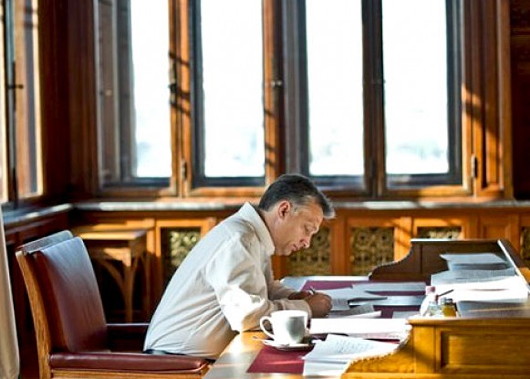
F.C. Kolbe and the Tulbagh Drostdy
the Tulbagh Drostdy
Poet, Polemicist, Polymath, and Priest
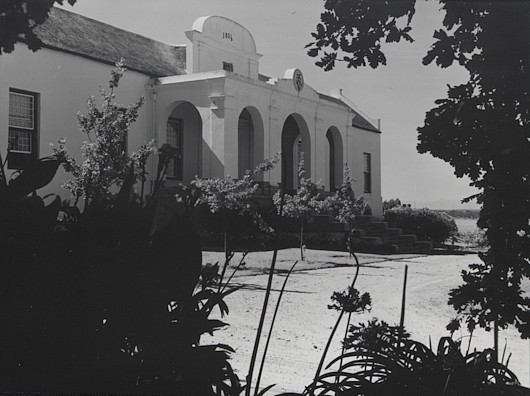
Relic and emblem of a storied past.
Thrice happy they whose lines in thee are cast
Thy records summon all in thy embrace
To emulate the virtues of the race.
Thy stately halls of courtly manners tell,
Where only Ladies Bountiful should dwell.
Thy solid frame is pledge of future glory,
And links our doings with our country’s story.
Work on the Drostdy (magistrate’s house) at Tulbagh in the Western Cape began late in 1804 but progressed rather slowly and expensively. This is probably because — after construction commenced — the plans by Bletterman, the landdrost at Stellenbosch, were torn up by the architect Louis Michel Thibault and replaced by his own design.
This meant part of the work already completed had to be demolished and re-done, which Bletterman only went along with assuming Thibault’s plan had the approval of the Batavian Republic’s governor of the Cape, Jan Willem Janssens. As it happens, they did not, and when Bletterman found out he was none too pleased.
Francis Masey, a partner at Herbert Baker’s firm, noted that “[w]hilst it proved to be the last building begun upon Dutch soil in South Africa, it was destined to be the first completed upon the passing of the Cape into the hands of the British.”
This 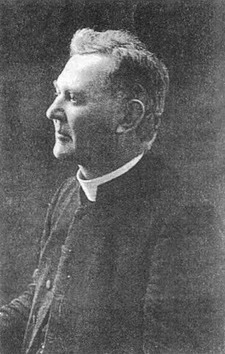 brief ode was written by Frederick Charles Kolbe (right) in 1909. The great-great-grandson of the magistrate (or landdrost) at Stellenbosch, F.C. Kolbe was the son of a Congregational missionary in Paarl who studied law at the Inner Temple in London. There, in 1876, he was received into the Catholic Church and continued on to study in Rome where he was ordained a priest in 1882.
brief ode was written by Frederick Charles Kolbe (right) in 1909. The great-great-grandson of the magistrate (or landdrost) at Stellenbosch, F.C. Kolbe was the son of a Congregational missionary in Paarl who studied law at the Inner Temple in London. There, in 1876, he was received into the Catholic Church and continued on to study in Rome where he was ordained a priest in 1882.
While his poetry was tended towards the middling, Kolbe was a distinctive polymath. In addition to catechetical writings, he published a number of works on Shakespeare, and lectured on Socrates not long after his 1882 return to the Cape. Eventually he was appointed Reader in Aesthetics at the University of Cape Town.
Kolbe also wrote a Catholic criticism of the 1926 book Holism and Evolution by the statesman General Smuts. (Not many people realise that the word ‘holistic’ was donated to the English language by a son of Stellenbosch.) The general and the priest had corresponded as early as 1915 when Smuts was Minister for Defence, and Smuts was so taken with Kolbe’s critique that he wrote a foreword to a later edition of it.
In a 1935 letter to “Dr. Kolbe”, the General wrote:
Although I am not acquainted with the Catholic prayers, I am deeply versed in the Psalms of the Old Testament, which seem to me the greatest and noblest outpourings of the human spirit ever put into language. The inexpressible finds expression there. Emotions almost too deep for utterance somehow find an outlet there. …
I also agree with you as to the nobility of the language which Catholic Christianity has evolved. What could match the beauty of De Imitatione Christi? Somehow it breathes a spirit which is beyond all language. It is curious how in such a case the human soul sets on fire its own earthly vesture, and language becomes a blaze of glory…
From Smuts’ letters to others we know that he actually read more works by Kolbe, in particular his Up the slopes of Mount Sion: or, A progress from Puritanism to Catholicism.
Disputation and discussion were also among Kolbe’s talents. He used the pages of South Africa’s Catholic Magazine to counter the accusations of what he called a “narrow clique” of anti-Romish ministers of the Dutch Reformed Church.
One of Kolbe’s most lasting legacies was the effect of his writing on the young Afrikaner philosopher Marthinus Versfeld (1909–1995) who converted to Catholicism under the late Monsignor’s influence. (Kolbe had died in 1936.) Versfeld’s familiarity with Augustine and Aquinas helped him launch intellectual attacks against the so-called “Christian-national” thinking behind apartheid, particularly in his first book Oor gode en afgode (“Of Gods and Idols”, 1948 & republished 2010).
Kolbe, according to Versfeld, “lived out a certain apprehension of the presence of the universal in the particular, just as Newman lived out his vision of the Catholic Church in the material of English circumstances.”
An Afrikaner Newman, perhaps? Worth reading more about.
Urgent Action for Catholic Free Schools
Since the Free Schools programme was introduced in 2010 (allowing parents and other groups outside the state to start and run schools) more than 400 new schools have been approved for opening, providing over 230,000 new school places across the country.
During the Coalition, though, the Liberal Democrats insisted on putting a 50% cap on admissions for free schools that are faith-based. Because Catholic schools are not allowed to reject Catholics simply because of their faith, the policy’s only real effect has been to entirely prevent any Catholic free schools from opening, while failing to do anything about the integration of religious or ethnic minorities.
The Prime Minister has rightly pointed out that “Catholic schools are more ethnically diverse than other faith schools, more likely to be located in deprived communities, more likely to be rated Good or Outstanding by Ofsted, and there is growing demand for them.”
As the British population has increased, the shortage of new Catholic school places has only become more alarming. When the Prime Minister announced the cap would be dropped, Catholic dioceses sprang into action making plans for Catholic free schools. Some even bought sites, one being located next to a hospital to educate the children of immigrant nurses and medical staff who’ve come from Catholic countries to staff our NHS.
But right now Catholic free schools are under threat. Despite a solemn commitment in the Conservative manifesto, Education Secretary Justine Greening is believed to be inclined to make a U-turn and keep the admissions cap which acts as a ban on Catholic free schools.
I ask that you email your Member of Parliament right now, asking him or her to contact the Education Secretary and request that this manifesto commitment be honoured and the faith-based admissions cap be scrapped. A decision is likely to be made very shortly, so time is of the essence.
Many thanks,
Andrew Cusack
To find your MP’s contact details, put in your postcode at this link.
As one of your constituents I am writing to ask you to help scrap the faith-based admissions cap for free schools.
The Government is right to be concerned about the integration of religious and ethnic minorities. This policy, however, began with the best of intentions but has been proven a complete and utter failure. Exhaustive research has proved the cap is completely ineffective towards its stated aim.
Canon law forbids Catholic schools from rejecting fellow Catholics purely on the basis of their faith, which the admissions cap requires. The cap’s only real effect has been to prevent the foundation of Catholic free schools, despite the dire need for quality school places amongst the poorest in our communities.
Catholic schools, meanwhile, are profoundly diverse and educate the children of many faiths and of none. More than 26,000 Muslim pupils are currently receiving education in Catholic schools. One in seven ethnic minority pupils in England & Wales attend a Catholic school, including more than one in five black children.
Across the board, Catholic schools educate 21% more pupils from ethnic minority backgrounds compared to other schools, and these pupils in Catholic secondary schools perform better at GCSE than the national average. These schools also have a record second to none in looking after the most disadvantaged in our society. 16.5 % of pupils in Catholic secondary schools live in the most deprived areas, compared to 11.3% nationally.
Before the election, the Conservative government openly stated its intention to scrap the faith-based admissions cap, which requires only the Education Secretary’s signature to be enacted. The Conservative party then went to the nation in a general election and included this promise in its manifesto.
I ask that, as my MP, you urgently contact Justine Greening MP, the Secretary of State for Education, and ask her to honour the manifesto commitment to scrap the faith-based admissions cap.
Yours,
NAME
FULL POSTAL ADDRESS
First Gypsy Woman Martyr is Beatified
Emilia Fernández Rodríguez was killed during Spanish Civil War
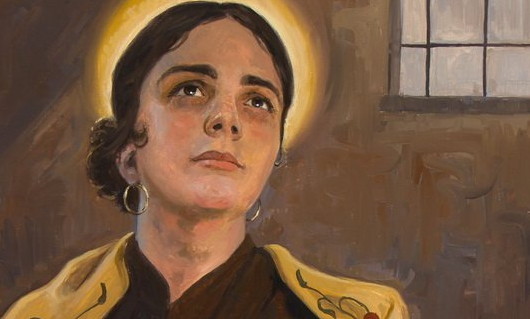
The Catholic Church has beatified its first gypsy martyr in a ceremony in the Spanish city of Almería on the southern Mediterranean coast. Emilia Fernández Rodríguez, also known as “La canastera” (the basket-weaver), was one of 115 martyrs murdered in odium fidei by anti-Catholic militants during the Spanish Civil War.
The beatification ceremony took place in the city’s conference centre attended by over 5,000 people, including twenty-one bishops and four cardinals.
In 1938, Blessed Emilia Fernández was a poor gypsy woman living with her husband in Tíjola and surviving by basket weaving when the Republican forces occupied the town, shutting its church, and conscripting its menfolk. Emilia’s husband Juan with her help feigned blindness to escape conscription but was discovered and the couple were imprisoned separately.
Arriving at the women’s prison in Gachas-Colorás, Blessed Emilia was already pregnant and was jailed alongside many other practicing Catholic women who had refused to abjure their faith. Illiterate and never having been catechised despite being baptised, Blessed Emilia was taught how to pray the Rosary by another inmate. Her devotion to this Marian prayer and meditation attracted the ire of the prison authorities who threw her into solitary confinement for refusing to reveal which of her fellow inmates had catechised her.
After the birth of her baby girl, Ángeles, Blessed Emilia died as a result of her weakened condition from malnutrition and the appalling conditions of her isolation. Just twenty-three years old, her body was dumped into a common grave in Almería.
Challoner’s House
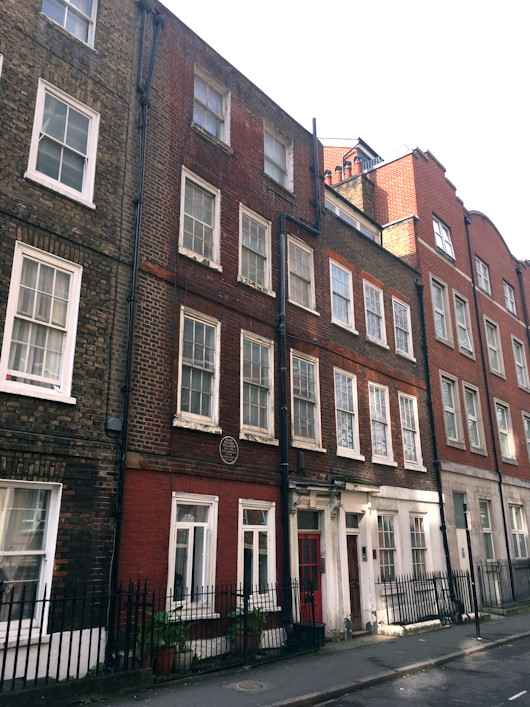
Challoner’s House — Rather humble for an episcopal palace, but such was the function of No. 44, Old Gloucester Street in Holborn during the time of Bishop Richard Challoner.
If it seems an odd spot for London’s Catholic bishop, it can be explained by its close proximity to the chapel of the Sardinian Embassy off Lincoln’s Inn Fields. At this time, of course, the Mass was still illegal and the only places Catholics in London could worship were the embassies of the Catholic nations. To protect the underground bishop, the house in Old Gloucester Street was actually rented in the name of his housekeeper, Mrs Mary Hanne.
After a perfect breakfast on Saturday morning the sun was shining so I decided the three-and-a-half miles home from St Pancras were best managed on foot. If architectural or historical curiosities are your fancy then foot is the way to travel, and so it was by pure chance that I stumbled upon No. 44. It seemed particularly appropriate that the night before a whole gang of us — Brits, Swedes, Italians, etc. — had been drinking in the Ship Tavern in Holborn where Bishop Challoner was known to offer the occasional clandestine Mass. (more…)
The Old Scots College
Via delle Quattro Fontane, Rome
Next month I’m off to Rome and the last time I was there I happened to walk past the old Scots College on the via delle Quattro Fontane. The Pontifical Scots College is probably the oldest Scottish institution abroad and certainly one of the most important, both historically and today. As Scotland’s primary seminary it has — almost literally — helped form the soul of the country, particularly during times of widespread persecution back in the mother country.
The church of Sant’Andrea degli Scozzesi (St Andrew of the Scots) was built in 1592 during the reign of Clement VIII, and early in the seventeenth century the church and neighbouring hospice were given over to the Scots College which had been founded a few years before. The seminary building itself was (I believe) built much later, in the nineteenth century after the college briefly ceased instruction due to the tumult of the French Revolution.
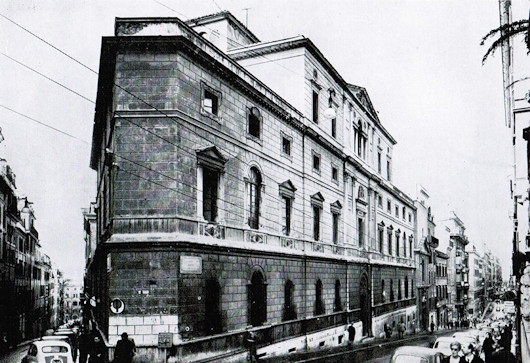
Sadly the building was not very well maintained and by 1960 it was falling apart. It was decided to sell the old college buildings in the Via delle Quattro Fontane and move to a larger site out the middle of nowhere in the Via Cassia. The move was made in 1964, and the Scots College has remained there ever since, while the old college housed a bank for many years and more recently a lawfirm.
The L.A. Times on Papa Pacelli
How News of the Election of Pius XII was Received in 1939
The case against Pope Pius XII, accusing him of complicity in the crimes of Nazism, has been so thoroughly debunked — by Jews like Gary Krupp and Rabbi Dalin more than any — that it is no longer even worth refuting.
Still, it’s interesting to read the Los Angeles Times’s coverage of his election as Supreme Pontiff in the difficult year of 1939:
BLOW TO NAZIS
… The choice of Cardinal Pacelli is believed certain to provoke annoyance in Germany, where he long has been regarded as a moving spirit behind the Vatican’s opposition to Nazi policies.
As the news report goes on to note, Cardinal Pacelli was elected in only three ballots — the quickest papal election since that of Leo XIII in 1878.
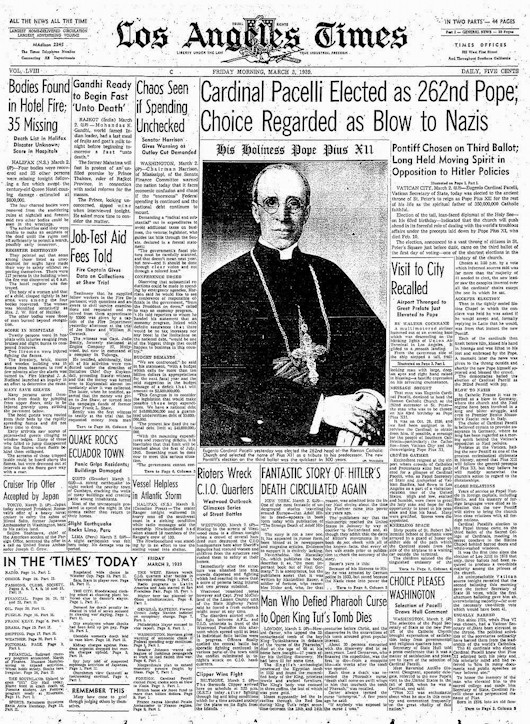
The Ordination of a Priest
Michael Rennier and I first met some years ago as we moved in the same vaguely intellectual circles that congregated in various places between New York and Boston. He was an Anglican clergyman then, having been raised a Pentecostal Christian and endured a long sojourn in the Episcopal Church in which he was called to formal ministry. Michael disguises his intellectual rigour with a light heart and a good sense of humour, and I was deeply pleased to see that rigour guided him, his wife, and family into the Catholic Church in 2011. I believe he had been knocking on the doors of the Archdiocese of Boston asking to be brought in under the Pastoral Provision of John Paul II, but I imagine the last thing that Archdiocese wanted to take on was the cost of a man with a wife and kids to look after as a seminarian, then deacon, then priest.
Things moved along anyhow, and Michael moved his family back to his ancestral homeland in the Middle West – T.S. Eliot country – to find his way in life and see what the future would bring. Thanks be to God, last week, on the feast of the Immaculate Conception, Michael was ordained a priest of the Catholic Church at the Old Cathedral of Saint Louis in Missouri.
In a beautiful reflection, Michael recalls sitting in Yale’s Sterling Memorial Library as a Protestant clergyman-in-training:
I was reading the Apologia; the story of [John Henry Newman’s] conversion to the Catholic Church. I was particularly bothered by one specific bit. I was at the part where Newman makes his point that, fundamentally, there is no difference whatsoever between Arianism and Anglicanism. One is reviled and discredited, the other respectable and vital. But look closer, Newman argued, look underneath. What is there? Rebellion. There, buried beneath the sartorial splendor, the monarchy, the gorgeous liturgy, the incense, the polyphonic chant, and the prestige of Oxford… was a group of Christians steeped in the bitter throes of willfulness. […] Newman got to me that day, blinking in the fluorescent lights of a now disappeared world. My own world, comfortable as it had been, began to slip away as well.
After all, outward appearances are not always what they seem.
Further along, Michael relates attending Mass as a Protestant:
It was fascinating. I was attracted to it. I felt something solid about it, comforting, and yet, I knew for a fact that these people worshiped statues! Okay, with age my critique became a bit more subtle. But in the long run, aren’t all our arguments against the Church just as silly and vain? She outlasts us all. We can kick and scream and throw tantrums; legislate against her, slander her, outlaw her priests and persecute her children: the Church still prevails. She fears nothing. And because of this, she is able to be generous and patient.
The greatest novel of all time (no one argue with me on this) is Brideshead Revisited by Evelyn Waugh. In it, Waugh describes a family who keep their country seat at Brideshead in the ancestral home. The family itself is a mixed lot; A father living abroad in sin, a domineering mother, a son who is a flamboyant dandy, a worldly daughter, and an overly-childlike daughter. Waugh describes the slow decline of Brideshead as the family disintegrates and scatters. This dissipation works itself out universally in the advent of the Great War [sic], which finally swallows up all of England and turns Brideshead into quarters for Army command. In the end, though, we are left with a scene in the house’s private chapel, where the altar lamp is still lit and a lone priest says mass for an old woman. I am a lot like that family. Many of us probably are.
You see, conversion is a gift. Mother Mary holds her Son for us, patiently suffering at the foot of the Cross. We can ignore her, go our own way, rebel … it doesn’t matter. Hanging on the Cross, Christ says to each and every one of us “Behold your Mother.” She is here still. Waiting. We may be elsewhere, doing God knows what, but above the altar the candle still flickers. This is the light by which, in time, we find our way home.
His reflection is worth reading in full.
I hope readers will join me in getting a prayer of thanksgiving in for Fr Michael as well as for his wife and their five children. This is barely even the beginning.
Mendicant Architecture in Mediaeval Oxford
An interesting video from two American academics on the subject of Mendicant architecture in mediaeval Oxford, with some three-dimensional theoretical reconstructions of the Dominican and Franciscan houses in the city.
Both orders returned to Oxford in the twentieth century. The Capuchins refounded Greyfriars in 1910 and it was recognised as a permanent private hall (PPH) of the University in 1957. Its end as an academic institution was announced sadly on its fiftieth anniversary in 2007, but Greyfriars continues as a Capuchin friary.
Blackfriars under the Dominicans is still going strong, exercising a triple function as a priory of the Order of Preachers, a house of studies for the English province of the Order, and a PPH of the University of Oxford.
Church of St James, Spanish Place
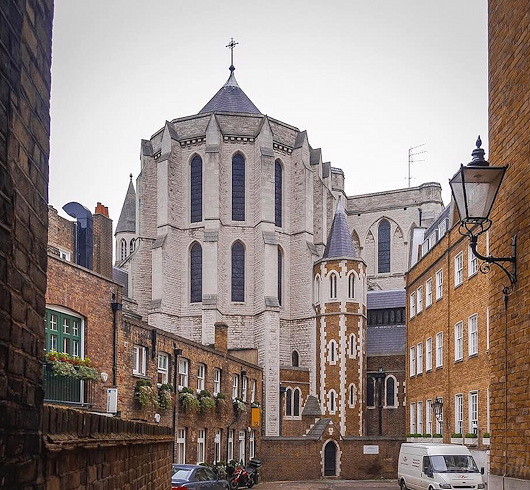
Always interesting to see a building you know well from a perspective you’ve never seen before, as in this photo of the Church of St James, Spanish Place, taken from Manchester Mews. The church somehow seems more imposing — like a great rounded keep.
A few months ago I was corralled into some favour or other that required a bit of muscle to move this there and whatnot, the payoff of which was it afforded an opportunity to explore the triforium of this Marylebone church and see the interior of the building from an entirely new vantage point.
It also meant being able to view in better detail the beautiful stained glass windows — many of them the gift of various Spanish royals, given that this parish originates as the chapel of the Spanish embassy (hence its name).
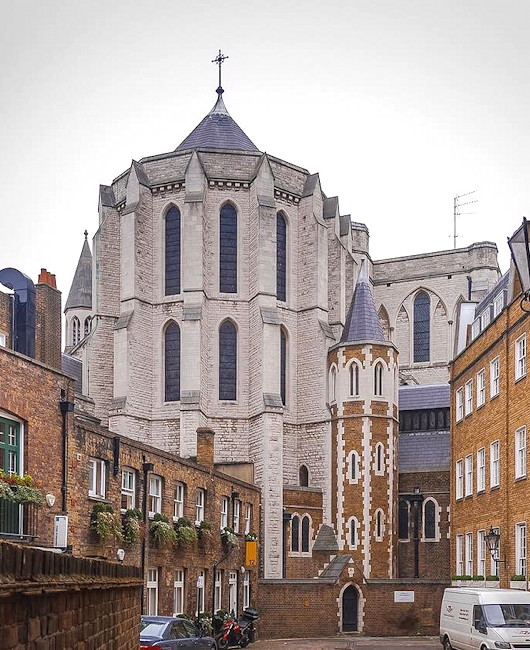
Letter to the Editor
A letter to the editor printed in this week’s edition of The Tablet:
Brendan Walsh’s report (“Heythrop’s fate”, 17 September) of a senior academic suggesting that the demise of Heythrop was an episode in a long struggle between “outward-facing, inquisitive, challenging” theology on one side and “inward-looking, submissive, unquestioning” theology on the other is telling.
Positing such a simplistic binary split between Enlightened Me and Poor Ignorant You is patronising to those attempting to live out the radical beauty of the Christian life in tune with Catholic teaching. It’s not surprising that an institution with academics holding this view is entering its death spiral, while religious communities that don’t consider basic orthodox belief as optional are bursting at the seams.
Few things are more challenging – and more rewarding – than faithfulness; while some cling to clapped-out heterodoxies and managed decline, the rest of the Catholic world has moved on.
ANDREW CUSACK
London SW1
The Red Mass in Edinburgh
The opening of Scotland’s judicial year was marked this past Sunday by the Archbishop of St Andrews & Edinburgh offering the customary Red Mass in St Mary’s Cathedral.
This year Archbishop Leo Cushley was joined by Lord Drummond Young and his fellow Senators of the College of Justice, Lord Uist, Lord Doherty, Lord Matthews, and Lady Carmichael.
Gordon Jackson QC, the Dean of the Faculty of Advocates, and Austin Lafferty of the Law Society of Scotland joined many sheriffs, QCs, advocates, solicitors, trainee solictors, paralegals, and law students.
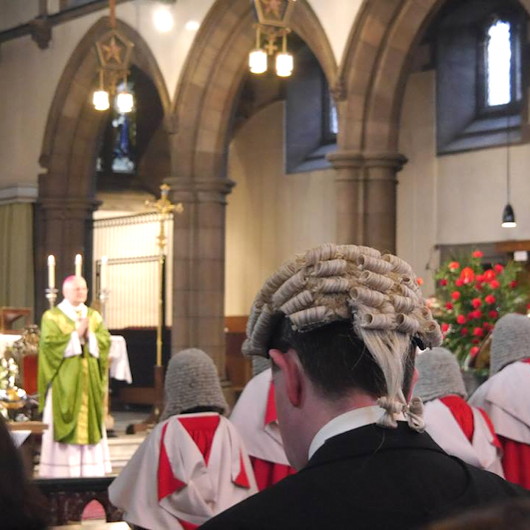
“These men and women serve the nation in a high office and come here to ask the Lord’s blessing upon this year’s work that they carry out on our behalf,” Archbishop Cushley noted in his homily.
“Know that we appreciate the difficult and complex tasks that you have and the duties that you perform – which are very onerous – on behalf of us all and that you be assured of our prayers and our support for all that you do to apply the law of the land with virtue and with justice and with mercy.”
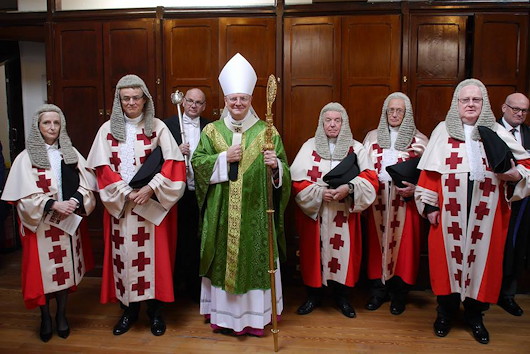
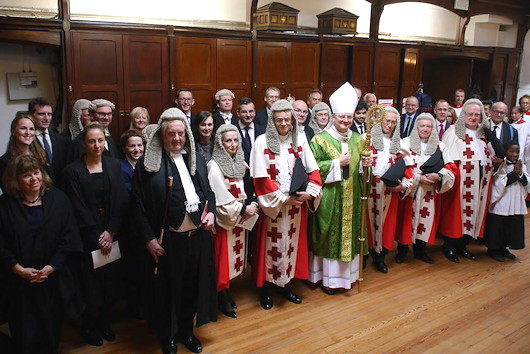
The Spina di Borgo
The Baroque is a style of joy. It is often hailed (or derided) as the most Catholic of styles and in some sense this is true. The festivity and physicality of the Baroque reflect the God that Catholics worship — “the Love that moves the Sun and other stars” as Dante put it — but a Love made incarnate, made man, in a very real and tangible world.
The Baroque is also the style of the surprise: the corner turned to an unexpected vista or the jet of water sprinkling a king’s unsuspecting courtier.
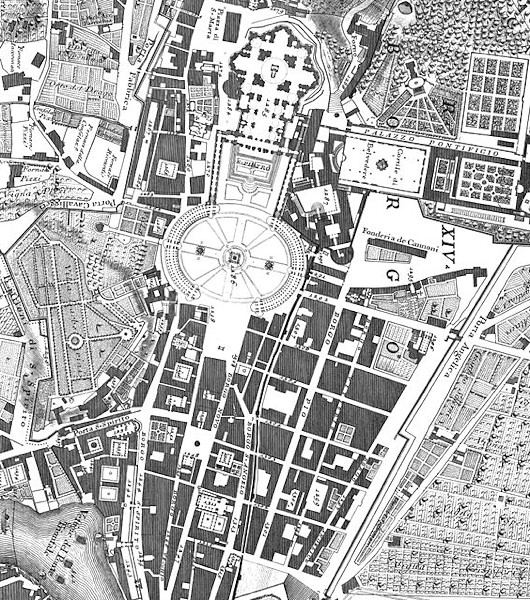
One of the most superb examples of this was the great basilica church of Saint Peter in Rome where prince, pilgrim, and pauper alike moved in a dark warren of palaces, hovels, churches, and alleyways, perhaps catching an occasional glimpse of the great dome looming as they closed in on San Pietro, finally to emerge from the shadow into the great light of the piazza.
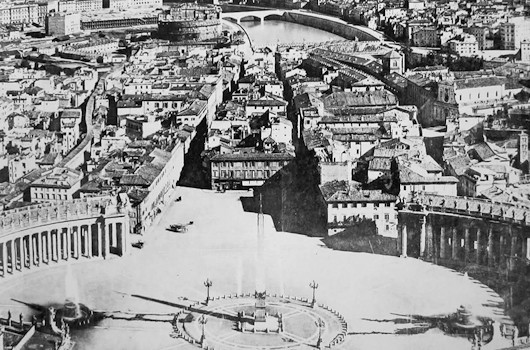
That warren of buildings was the Spina di Borgo (“Spine of the Borgo”) but this experience is now sadly lost to us since the 1930s when the Kingdom of Italy’s fascist premier Benito Mussolini decided to raze the neighbourhood. Instead we now have the long boulevard called the Via della Conciliazione, named in commemoration of the Lateran Treaty establishing formal relations between the Holy See and the Italian state.
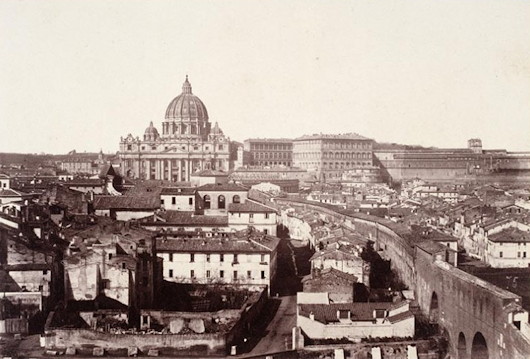
While Il Duce ostentatiously took credit for this urban crime by symbolically swinging the pickaxe beginning demolition, the concept, though flawed, was in fact an old one. Leon Battista Alberti submitted proposals during the reign of Pope Nicholas V (mid fifteenth century), and numerous other architects — Carlo Fontana, Giovanni Battista Nolli, Cosimo Morelli — drew up similar plans. The Piazza San Pietro only took its now instantly recognisable form in the 1650s when the curved flanking collonades enclosed the space like great welcoming arms superbly framing the basilica’s façade.
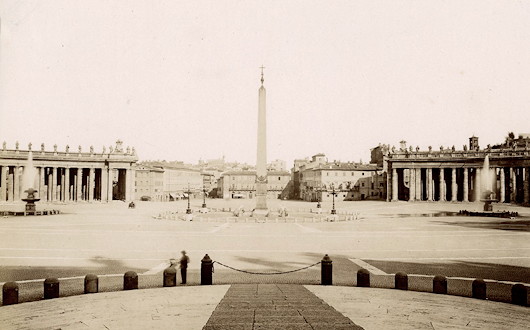
Mussolini turned to Marcello Piacentini — an accomplished if sometimes uneven architect — assisted by Attilio Spaccarelli. Piacentini favoured closing off the view from the avenue with a closed collonade, echoing Bernini’s own plans for the piazza, but was overruled.
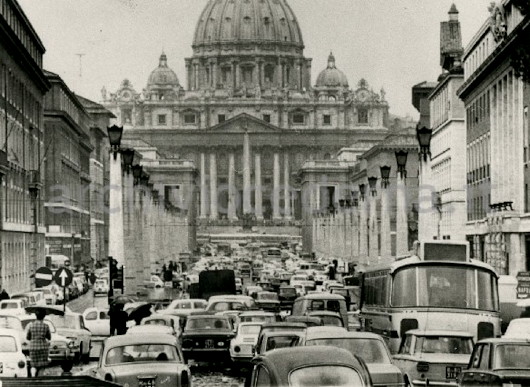
The razing of the Spina presented a problem in that the undemolished buildings left flanking the Via della Conciliazione were now mostly at odd angles to the new boulevard. Piacentini attempted to solve this by flanking the road with two rows of obelisks that doubled as streetlamps providing a line directing the viewer towards the great basilica beyond, otherwise unimpeded by any visual interruption.
Overall the construction of the Via leaves a rather boring and clinical feeling. The charm and chaos of the Spina has been replaced by a clean and dull boulevard, useful for little more than traffic efficiency and crowd control. The loss of the Spina di Borgo is mourned.
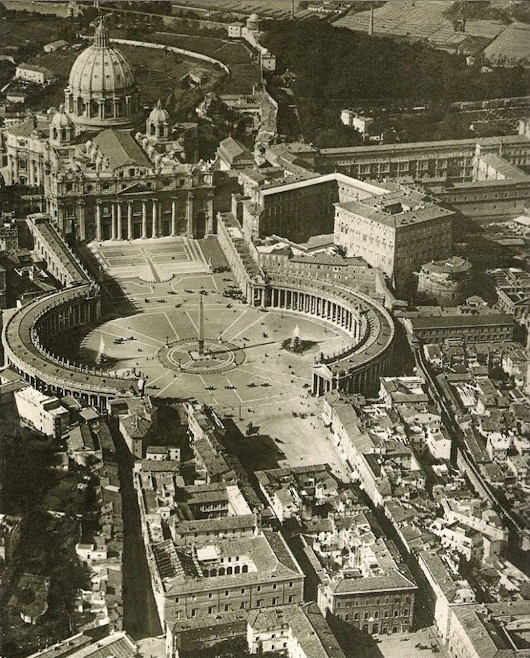
Master Mitsui’s Ink Garden
Daniel Mitsui is one of the most interesting artists out there, exhibiting a wide range of influences from the Celtic to the Oriental. Among his latest works is an ink drawing on a Catholic theme. As Daniel explains:
I received a commission to create a Catholic religious drawing in a Chinese style. These explorations into artistic traditions outside of European Christendom are always exciting, and China was new territory for me. When developing the concept for the project, I looked to one of the early missionaries to China, the Italian Jesuit Matteo Ricci.
Some time in the very early 17th century, Ricci gifted four European prints to the Chinese publisher Cheng Dayue: two engravings by Anthony Wierix from a series illustrating the Passion and Resurrection of Christ, another by the same artist reproducing the painting of the Virgin of Antigua in Seville Cathedral, and one by Crispin De Pas the Elder from a series illustrating the life of Lot.
Master Cheng copied these images into his Ink Garden, a model book of illustrations and calligraphy. The missionary saw this as a good opportunity to disseminate lessons in Christian doctrine and morality among the Chinese population.
Continue reading here.
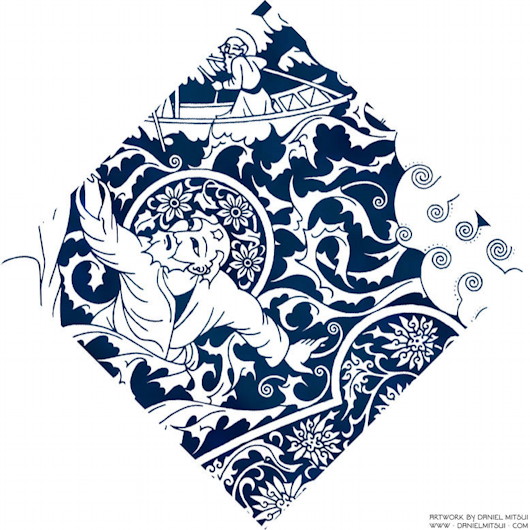
Joy
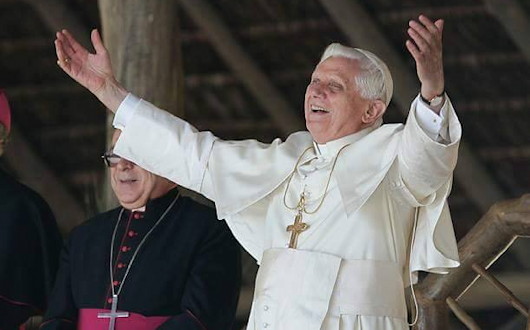
Something I constantly notice is that unembarrassed joy has become rarer. Joy today is increasingly saddled with moral and ideological burdens, so to speak. When someone rejoices, he is afraid of offending against solidarity with the many people who suffer. I don’t have any right to rejoice, people think, in a world where there is so much misery, so much injustice.
I can understand that. There is a moral attitude at work here. But this attitude is nonetheless wrong. The loss of joy does not make the world better — and, conversely, refusing joy for the sake of suffering does not help those who suffer. The contrary is true. The world needs people who discover the good, who rejoice in it and thereby derive the impetus and courage to do good. Joy, then, does not break with solidarity. When it is the right kind of joy, when it is not egotistic, when it comes from the perception of the good, then it wants to communicate itself, and it gets passed on. In this connection, it always strikes me that in the poor neighborhoods of, say, South America, one sees many more laughing happy people than among us. Obviously, despite all their misery, they still have the perception of the good to which they cling and in which they can find encouragement and strength.
In this sense we have a new need for that primordial trust which ultimately only faith can give. That the world is basically good, that God is there and is good. That it is good to live and to be a human being. This results, then, in the courage to rejoice, which in turn becomes commitment to making sure that other people, too, can rejoice and receive good news.
Lourdes: To Be a Pilgrim
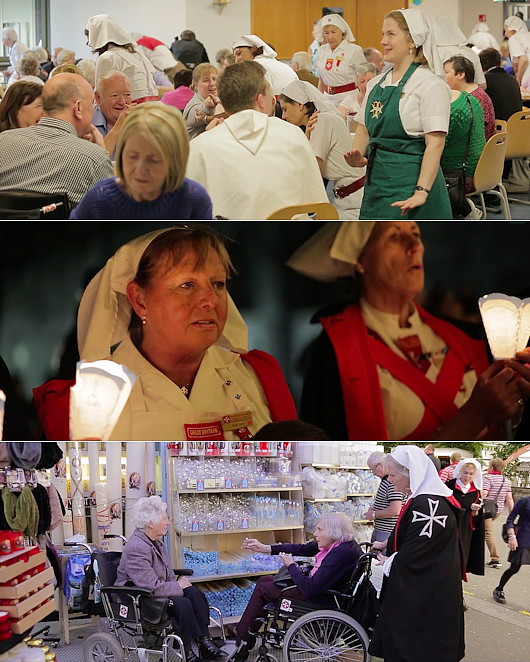
As today is the feast of Our Lady of Lourdes — and consequently the World Day of the Sick — here is the documentary we made regarding the Order of Malta’s annual pilgrimage to Lourdes each May.
No ‘Malvinas’ Here
Some difficulties of Latin place names in 1930s cartography
It’s no great secret I’m a lover of maps. When calling in to the Secretariat of State on the terza loggia of the Apostolic Palace in the Vatican the other day, I was very pleased to see the cartographic murals there, including the two hemispheres done by Ignazio Danti in the 1580s. Moving to the next interior offices, however, the visitor is greeted by a much more recent mappa mundi, dating from the 1930s, replete with the glamour of empire’s heydey. (more…)
Chartres 2015
Chartres is filed in my mind as the cathedral of my childhood. I must’ve been around 4 or 5 when I first walked amidst this medieval vision of stone and stained glass — some years before I ever visited the cathedral of New York where I was born. Cathedrals offer a prodigious mental stomping ground for the imagination of a young boy, and David Macaulay’s pen-and-ink book Cathedral (winner of the 1975 Deutscher Jugendliteraturpreis — take note!) I read and re-read over and over again as a child.
The marvel of this great church is that, while most medieval cathedrals took centuries to build, Chartres was constructed in an astonishing fifty-four years between 1194 and 1250, lending it a unity as an architectural composition that puts its rivals to shame. Chartres was made a diocese as early as the third century and tradition even upholds that from around the year 50 B.C., local Druids who had heard the prophecies of Isaiah here enshrined a statue of the ‘Virgo Paritura’, the Virgin-who-will-give-birth.
Having such a long history, Chartres’ fortunes have waxed and waned. In medieval times it was one of the most popular pilgrimage shrines in all of Europe, and in the 11th and 12th century its cathedral school far outshone England’s provincial attempt at a university at Oxford. But France’s civil wars and then revolution put an end to the town’s days as a destination for pilgrims until the poet Charles Péguy revived them himself in the years leading up to the First World War.
For the past thirty-three years, the largest pilgrimage to Chartres has been undertaken over Pentecost weekend, a bank holiday in France which happily coincided with our second May bank holiday in Great Britain this year. On this trek, over 11,000 pilgrims walk all the way from Notre Dame de Paris to Notre Dame de Chartres. Our chapter of about twenty pilgrims marched under the banner of Notre Dame de Philerme, patroness of the Order of Malta — mostly French and British but with a few participants from other countries as well. (more…)
Faith, Freedom, and Respect
Religion grows in the very depths of our being. Mocking it, ridiculing it, can be especially hurtful.
by FRANÇOIS HUGUENIN
Unanimous France has marched on January 11 in the name of Charlie to defend freedom of expression. Is it useful to say at the start that, at this moment of national unity, I agree with the condemnation of these heinous acts of terrorism and that I welcome hearing some courageous voices dare to finally name the danger — radical Islamism? But I am surprised and worried to see a France that, with the resultant “diversity” noticeable in its absence, is becoming a supporter of a newspaper that it never bothered to read. The defence of freedom of expression seems to have created an epidemic of blindness with respect to the problems, not of the freedom to express ideas, but of the manner in which that freedom is used.
It is clear that freedom of expression is regulated in France, since some words (such as those inciting racial hatred) are legitimately subject to prosecution, while there are no laws against blasphemy. But the question posed by the humour of Charlie Hebdo, that everyone will enjoy according to their own standards, seems to be beyond the law. If liberty is a core value of our society, conquered after many struggles, is it assigned an absolute value that is greater than all the others? Doesn’t the motto of our republic put it at the same level of equality and fraternity? In the name of fraternity, we can not take seriously a value that is unlikely to be framed in legal texts, as it is impossible to codify, and yet is inherent in the dignity of man and entered in the heart of everyone: that of respect for others. This is precisely what makes a large contribution to the charm of life: giving up one’s seat on the bus to let an elderly person sit; politely asking your neighbour to lower the volume of his music instead of yelling in the stairway “Turn it down!” — none of this is prescribed by law, but it makes life better.
Now, if there is a value to be respected in others, it is his religion. (more…)
Search
Instagram: @andcusack
Click here for my Instagram photos.Most Recent Posts
- Bicycle Rack April 29, 2024
- Burns Tower April 19, 2024
- Patrick in Parliament March 18, 2024
- Articles of Note: 13 March 2024 March 13, 2024
- Cambridge March 9, 2024
Most Recent Comments
Book Wishlist
Monthly Archives
Categories

